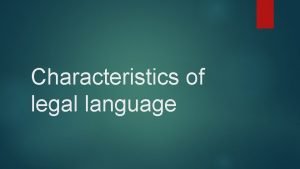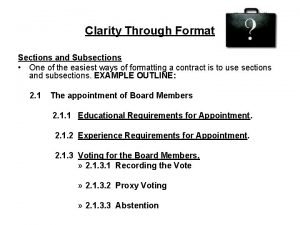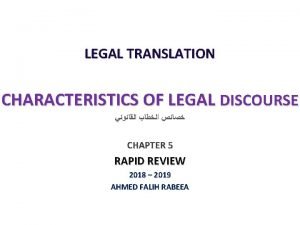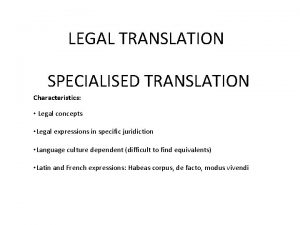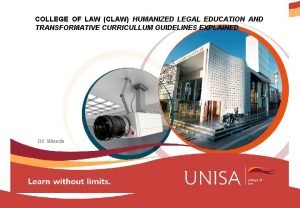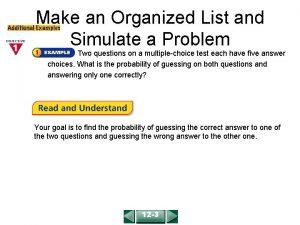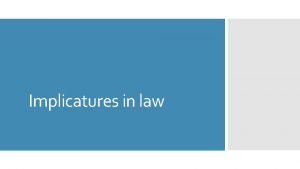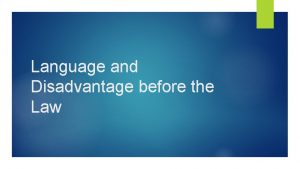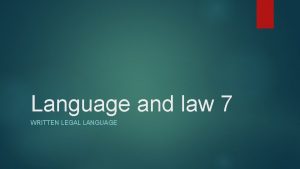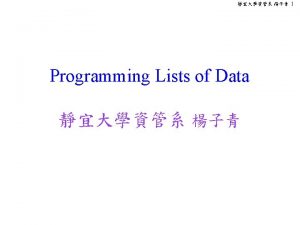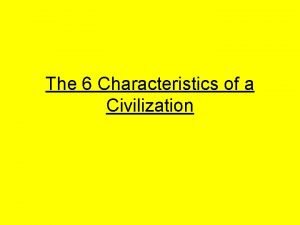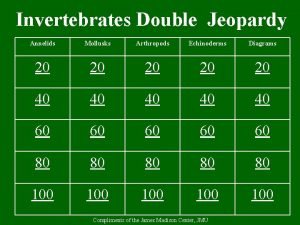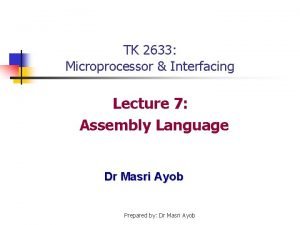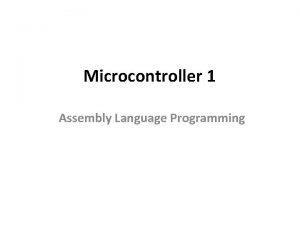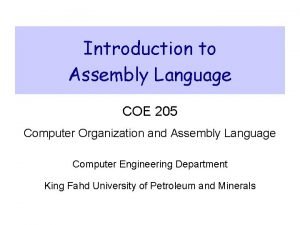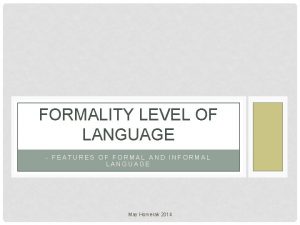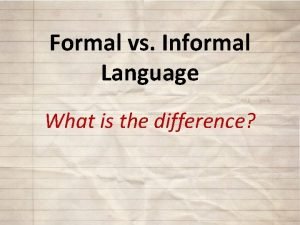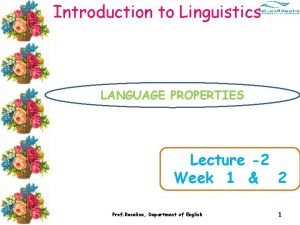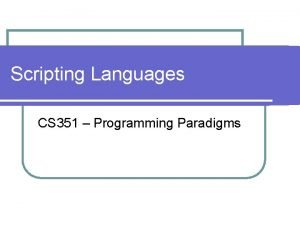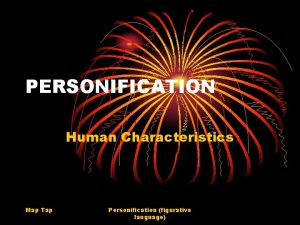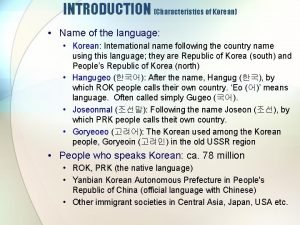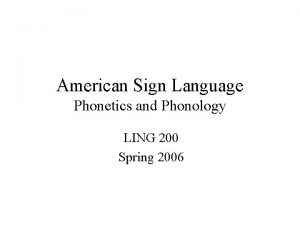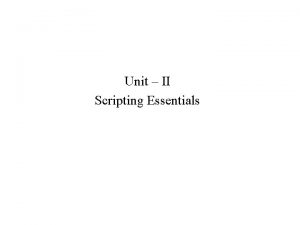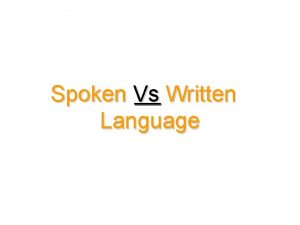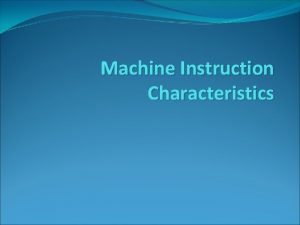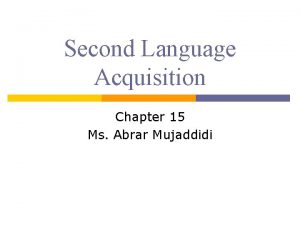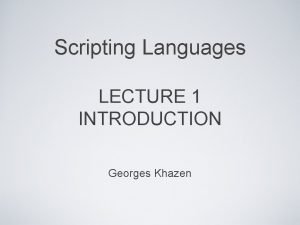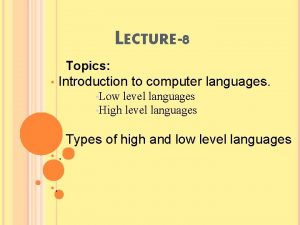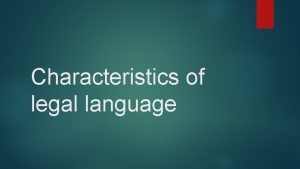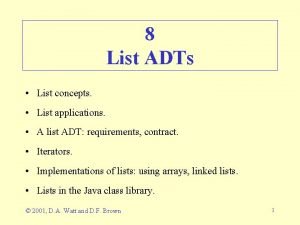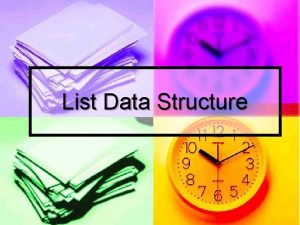Characteristics of legal language Activity Make a list


























































- Slides: 58

Characteristics of legal language

Activity Make a list of the kinds of features associated with legal language. Do not worry about the ‘proper’ name for the features; perhaps start just by writing down some examples or phrases that seem characteristic of legal texts www. law. cornell. edu

Written legal language Precision (e. g. definitions) Information overload Abbreviations Intertextuality Syntactic complexity Nominalization The use of doublets and triplets (breaking and entering, null and void, last will and testament) Archaisms Latin terms (ratio decidendi, obiter dicta, stare decisis)

Saying it twice: example Breaking and entering Null and void Fit and proper Aid and abet Goods and chattels

activity Consider the pairs above. Does each part of the pair mean the same thing? Look up each of the pairs in a dictionary

Synonyms? Goods and chattels: someone’s possessions, not including any houses or land that they own Goods is a term of flexible context and meaning and extends to all tangible items Chattel: an item of personal property which is movable, as distinguished from real property (land) Fit and proper: a very important requirement for admission as an attorney or advocate; (fit: in a good enough physical or mental condition; proper: morally good; serious) Aid and abet: To assist another in the commission of a crime by words or conduct Abet: to encourage, support, or countenance by aid or approval, usually in wrongdoing; aid: to provide support for or relief to; help:

Binomials After the Norman Conquest (1066) a large number of French words were borrowed It became comon to use both the English and the French term for the same concept or referent There was some doubt whether the words were full synonyms; it was safe to include both variants just in case there was a difference of meaning Another reason: the poetic function of language: binomials provide a certain rhythm; suggest formality and ritual, which are important to the law

Repetition I swear to tell the truth, the whole truth and nothing but the truth ‘the whole truth’ – ‘lies of omission’ are not allowed The formula has a poetic function, signals the importance of the oath

Properties required of legislative language 1. a law should be concise 2. Legislative language should respect rules of grammar (correctness) 3. It should use terminology consistently (precision) 4. It should avoid ambiguity (clarity) 5. Laws should be formulated in a logical way, and the reasoning should be coherent

Precision, vagueness and ambiguity in legal language „Natural language being such a breeding ground for ambiguity, to communicate just one set of meanings while excluding many others is often impossible; but the lawyer must at least make the effort, and legal language has many oddities that are clear evidence of the kinds of effort that have been made” (Crystal and Davy 1969: 193) Vagueness – acceptable in legal language (general statements) Ambiguity – not acceptable (multiple interpretations)

Precision: Definitions Legal terms may have multiple meanings (polysemy) Therefore, they are often defined within a particular context to avoid mistakes and misunderstandings Legal language – many definitions Corpus iuris civilis (Code, Digest, Institutes, Novellae; the Digest: 246 legal definitions)

Definitions Real and terminological Real d. : concern entities that exist in reality in the physical world (e. g. real property) “Goods are movable by their nature, or if the law so determines” Terminological d. only exist in legal reality (e. g. an obligation)

Example: MEANING OF “HOUSE” AND “HOUSE AND PREMISES”, AND ADJUSTMENT OF BOUNDARY. (1) For purposes of this Part of this Act, “house” includes any building designed or adopted for living in and reasonably so called, nothwithstanding that the building is not structurally detached, or was or is not solely designed or adapted for living in, or is divided horizontally into flats or maisonettes; and-

Example (cont. ) (a) where a building is divided horizontally; the flats or other units into which it is so divided are not separate “houses”, though the building as a whole may be; and (b) where a building is divided vertically the building as a whole is not a “house” though any of the units into which it is divided may be…. (p. 68)

Vagueness v. precision: examples Reasonable: Reasonable man Beyond reasonable doubt Reasonable force Reasonably foreseeable

Information overload Modern, complex society – enormous number of legal rules Legal language should be as concise as possible to avoid laws and regulations that would otherwise be over-long and unclear At the same time, legal language should avoid over-abstraction to enable decoding with minumum effort

Information overload The key: to know for whom laws are written – experts or citizens? Even laws concerning fundamental questions of citizens’ lives – written for experts who are charged with their technical application (e. g. fiscal law) Laws – highly complex: distributive justice, which presupposes highly detailed rules

Universality and aloofness Abstraction and Hypothetical Character Modern law-abstract character; regulates entities that are mental creations: rights and obligations; e. g. in Swedish legislation: only 5 -8% verbal substantives refer to entities that exist in time and space Law – based on experience drawn from the real world but it regulates hypothetical future cases; timespan linked to legal rules – often characterised by universality, impossible to see from the chronological standpoint: “timelessness of law”

Impersonality and Objectivisation Frequent use of passive: brings the object of the action into the foreground, giving the actor only a secondary role Even when actors are in the foreground, individuals are pushed into the background by personification of authorities and corporations: e. g. the ministry orders (…), the court finds(…)

Impersonality and Objectivisation Actors to do not appear under their private names but are called by their titles or functions: director, president, etc Private persons -named according to their roles: applicant, appellant, defendant Advocates seek to lend their arguments an appearance of objectivity to make them credible and convincing (e. g. “It appears that Article 27 of the law on judicial records should be interpreted so that (…); not: “It seems to me…)”

Neutrality Legal language today: official and formal Neutral style: to have an effect on the understanding, rather than the feelings, of the reader or listener Legal style: cold: rejects all that is affective and does not include emotional elements Legal texts: no exclamation or question marks Neutrality of legal language – guaranteed by the fact that many legal texts (laws, administrative instructions, on the Continent also judgments) pass through the offices of several commentators and stylists before receiving their final form: they are not from a single hand

Neutrality Legal language – characterised by “zero style”; however: advocates’ closing speeches are often affective Sobriety of legal language – visible in legislative texts; exceptions: preambles to laws, whose style is often full of pathos and emotion

Metaphor a figure of speech that describes a subject by asserting that it is, on some point of comparison, the same as anotherwise unrelated object. a type of analogy and is closely related to other rhetorical figures of speech that achieve their effects via association, comparison or resemblance All the world's a stage, And all the men and women merely players; They have their exits and their entrances;

Metaphors In contrast to medieval times, modern legal language is neutral; no longer figurative Only a few modest traces remain of the colourful legal language of the past, mostly in the form of legal maxims In modern legal language, metaphors are rare Metaphors: common in solemn speeches on the notion of law, its fundamental principles, etc. Metaphors e. g. “landscape of legal culture”

Metaphors “burden of proof” (Roman law: onus probandi: calques all over Europe: onere della prova, carga de la prueba, charge de la preuve, Beweistlast, bevisbörda, Source of law

Systemic character Interrelationship of different elements of the law Legal order – systemic character: each element forms part of a greater whole An article forms part of a law, and a law forms part of legislation. In civil-law countries, precedents complement legislation; in common-law countries they are of fundamental importance; legal science – also important; result: each element should be in harmony with the entirety of the legal order

Interrelationship of different elements of the law: intertextuality Systemic character of the legal order - components of the order linked to one another by references: intertextuality given that law relies on authorities (e. g. the legislator, the courts), a legal text has a dependent relationship with other texts; an article of the law refers to other articles of the same law or to other legislative texts, a judicial decision refers to laws, a legal textbook or treatise refers to laws, etc.

Functions of referencing 1. in reinforcing the systemic idea of the legal order, references are appropriate for eliminating internal contradictions 2. References show the wider contexts to which the different elements of the legal order belong; informative and mnemotechnical function. A reference shows that another legal text exists that links to the issue involved 3. References eliminate repetitions, the text becomes lighter and more economical

Problems of Referencing Too many references make a text difficult o understand, potentially causing mistakes and misunderstandings; a legal text becomes a “hypertext” weighed down with a large number of references making the reader lose thread of the document; such a text saves space but is very difficult from the reader’s stand-point

Problems of Referencing “A person who fails to make a declaration, or who does not make it in a correct or complete manner, or in due time, contrary to paragraph 2 of Art. 4, paragraph 1 of Art. 26, Art. 27, Paragraph 1 or 2 of Art 28, paragraph 1 or 2 of Art. 28 a, paragraph 2 of Art. 34 paragraph 1 or 2 of Art. 38 or paragraph 2, 3 or 4 of Art. 42, or who fails to attach the items prescribed by law to the declaration, contrary to paragraph 2 of Art. 26, paragraph 2 of Art. 34, paragraph 2 of Art. 38 or paragraph 3 or 4 of Art. 42, contravenes the law (decree implementing law on firearms, Art 43, p. 4) German legislation on firearms

Structure and formalism in legal texts: Logical disposition helps to place legal information in a hierarchy Legal text moves from the abstract to the concrete, from the substantive to the procedural Structure of the text should be consistent: the principal items presented before secondary items, general rules before special conditions and exceptions

Structure of legislative texts Logical structure of a code informs the reader about hierarchies of legal concepts and terms expressing those concepts Thanks to such a structure, it is easy for a lawyer or translator to find in a code the terms they are looking for and to establish the contexts in which these terms are used

Frequency of initialisations and acronyms Official title of a law, a publication, or an office can be long and complicated Ie. g. Receueil de jurisprudence du droit administratif et du Conseil d’Etat) The use of initialisation (RJDA) facilitates references to various texts Space-saving

Archaism and Solemnity The legislator seeks to ensure respect for legal rules, notably by linguistic means: solemnity The entry into force of a constitution – performed by a formula full of dignity A close connection between the gravity of a text and its archaic character

Syntactic complexity Productivity, compositionality, recursion – some of the universal properties of language Mechanisms of recursion: coordination and embedding Compound sentence – all parts of equal importance

Complex sentence Attention should be paid to relations between the clauses In older statutes – long sentences, no formatting and very little punctuation Complex sentences – harder to process than compound sentences

Complexity: Act of Settlement (1701) Whereasin the First Year of the Reign of Your Majesty and of our late most gracious Sovereign Lady Queen Mary (of blessed Memory) An Act of Parliament was made intituled [An Act for declaring the Rights and Liberties of the Subject and for setling the Succession of the Crown] wherein it was (amongst other things) enacted established and declared That the Crown and Regall Government of the Kingdoms of England France and Ireland the Dominions thereunto belonging should be and continue to Your Majestie and the said late Queen during the joynt Lives of Your Majesty and the said Queen and to the Survivor And that after the Decease of Your Majesty and of the said Queen the said Crown and Regall Government should be and remain to the Heirs of the Body of the said late Queen And for Default of such Issue to Her Royall Highness the Princess Ann of Denmark and the Heirs of Her Body And for Default of such Issue to the Heirs of the Body of Your Majesty And it was thereby further enacted That all and every Person and Persons that then were or afterwards should be reconciled to or shall hold Communion with the See or Church of Rome or should professe the Popish Religion F 1. . . should be excluded and are by that Act made for ever [X 1 incapable] to inherit possess or enjoy the Crown and Government of this Realm and Ireland the Dominions thereunto belonging or any part of the same or to have use or exercise any regall Power Authority or Jurisdiction within the same And in all and every such Case and Cases the People of these Realms shall be and are thereby absolved of their Allegiance And that the said Crown and Government shall from time to time descend to and be enjoyed by such Person or Persons being Protestants as should have inherited and enjoyed the same in case the said Person or Persons so reconciled holding Communion professing F 1. . . as aforesaid were naturally dead

Complex sentence: example (Bribery Act 2010) 1. Offences of bribing another person (1) A person (P) is guilty of an offence if either of the following cases applies. (2) P offers, promises or gives a financial or other advantage to another person, and (b) P intends the advantage (i) to induce a person o perform improperly a relevant function or activits, or (ii) to reward a person for the improper performance of such a function or activity

Structure If X then Y, or Y is true if X is true „There are of course many possible variations on this basic theme, but in nearly all of them the ‘if X’ component is an essential: every action or requirement, from a legal point of view, is hedged around with, and even depends upon, a set of conditions which must be satisfied before anything at all can happen (Crystal and Davy 1969: 203)

Anaphora The use of pronouns for a recurrent noun phrase – anaphora Legal texts – very low levels of pronoun use and hence low levels of anaphora of this kind

Nominalization An action can be encoded as a noun While legal language uses a small set of verbs, it uses a large number of complex noun phrases, and can be said to be ‘highly nominal’ Encoding sth as a noun, when it could be another kind of word – nominalization (Tiersma 1999: 77)

Nominalisation Can be explained in terms of ‘grammatical metaphor’ „In English, grammatical metaphor permits the dense packaging of information, particularly in the noun phrase or nominal group. This density plus the semantic mismatch between word class and meaning means that it can be difficult to understand” (Gibbons 2001: 450)

Nominalisation - example Trustee Act 2000 Section 3 General Power of Investment (1) Subject to the provisions of this Part, a trustee may make any kind of investment that he could make if he were absolutely entitled to the assets of the trust… Is there nominalisation here? 1. Subject to the provisions of this Part, a trustee may invest in any way that he could if he were absolutely entitled to the assets of the trust…

Searching for clarity Trying to avoid syntactic complexity, ambiguous words and unhelpful nominalisations – important in making legal language more accessible to lay reader Acquiring legal language is not limited to learning a set of terms; it is also about learning a new way of thinking, entering into a different language and a different world (Mooney 2014: 38) While the sign universes of legal language and ordinary language may be parallel, they are not isomorphic, i. e. they do not completely correspond

Plain English „Plain English does not involve the simplification of a law to the point it becomes legally uncertain. In particular, care needs to be taken that legal uncertainty is not created when dispensing with terms having established meanings for users of legislation. Plain English may involve a balance of simplicity and legal certainty to ensure the law is both easily read and understood and legally effective to achieve the desired policy objectives, (Queensland Government, 2011, section 3. 5. 1)

Plain language Legal language may be the most effective and comprehensible variety if the addressee is a legal professional Plain English is highly desirable for texts addressed to a lay audience The move from ‘legal English’ to ‘Plain English’ is similar to a translation Because of this, the move to Plain English requires the involvement of willing legal professionals who are blingual

Terminology 1) the set of practices and methods used for the collection, description and presentation of terms 2) a theory required for explaining the relationship between concepts and terms 3) a vocabulary of a special subject-field

Terms should be : Accurate Concise Easy to spell and pronounce Allow the formation of derivatives Linguistically correct Monosemous (having 1 meaning) , mononymous (consisting of one word), and a member of a term system

Legal terminology A) “pure” law terminology (estoppel) B) law terminology found in everyday speech (title ‘right’) C) everyday words assigned a special meaning in a given legal context (e. g. Frigaliment Importing Co. , Ltd. v. BNS International Sales Corp. , 190 F. Supp. 116 (S. D. N. Y. 1960), D) terms from other disciplines

Everyday words assigned a special meaning in a given legal context: example Welfare of Pigs Act 1998 – definition of a pig for the purposes of that law: “pig means an animal of the porcine species of any age, kept for breeding or fattening” If a pig fails to fulfil either of the two qualifying conditions, its owner stays outside the scope of that law

English legal terms Multi-word expressions and phrases Polysemy synonymy

Legal concepts Law – a social phenomenon Legal rules differ in different legal orders Legal concepts also differ

Legal concepts Where the concepts of two legal systems differ, the semantic domains of legal terms do not correspond with one another Historical interaction between societies: legal concepts of Sweden and Finland _ very close, since Finland formed part of the Kingdom of Sweden for over 6 centuries; England the US: English law was applied in the former colonies

Scientific terms introduced into law Terms from other sciences introduced into statutes The materials may introduce a specific meaning, broader or narrower than the scientific one Medical terms e. g. alchoholic or drug addict may be understood in law differently The scientific term becoming a legal term may acquire a different meaning

Polysemy When p. occurs, interpreters of the text should be able to assign to a term the meaning appropriate to the context Often – easy to distinguish between different meanings; sometimes – impossible to tell what is the correct interpretation of the text: ambiguity

Synonymy Opposite to polysemy: two or several terms express the same concept Synonymy – a common feature of legal terms In legal languages with several layers of language, such as English, this is especially frequent Legal English often expresses the same concept by an Anglo. Saxon term, a French term, and a Latin term

The future? Future legal language – more descriptive than conceptual and closer to ordinary language More guidelines with reference to the linguistic aspects of creation and application of law

Problems Some efforts directed towards the modernization of legal terms may not lead to an increase in their understandability Legal vocabulary – rarely used and understood in an isolated form Attempts to increase understandability should focus on the structure of legal texts The impact of modernization of legal vocabulary should not be overestimated
 Characteristics of legal language
Characteristics of legal language Hyatt legal plans attorney list
Hyatt legal plans attorney list Numbering a tabulated list in legal writing
Numbering a tabulated list in legal writing Make the lie big keep it simple
Make the lie big keep it simple Go make a difference we can make a difference
Go make a difference we can make a difference Dawes plan
Dawes plan Characteristics of legal translation
Characteristics of legal translation Characteristics of legal translation
Characteristics of legal translation Characteristics of african legal philosophy (lju4801)
Characteristics of african legal philosophy (lju4801) Reactants products and leftovers
Reactants products and leftovers Debye huckel equation
Debye huckel equation Aon and aoa diagram
Aon and aoa diagram Activity 1 introductory activity
Activity 1 introductory activity Activity 2 finding the sequence
Activity 2 finding the sequence Activity 2:
Activity 2: Activity 1 activity 2
Activity 1 activity 2 Learning task 2 look around your home
Learning task 2 look around your home Problem solving make an organized list practice 1-7 answers
Problem solving make an organized list practice 1-7 answers Functions of legal language
Functions of legal language Implicatures within legal language:
Implicatures within legal language: Disadvantages of legal language
Disadvantages of legal language Language
Language Axiom meaning in maths
Axiom meaning in maths Singly linked list vs doubly linked list
Singly linked list vs doubly linked list Singly vs doubly linked list
Singly vs doubly linked list List h shows account
List h shows account Fungsi linked list
Fungsi linked list Select list item list index too large
Select list item list index too large What characteristics make hair a useful forensic tool
What characteristics make hair a useful forensic tool 6 characteristics of a civilization
6 characteristics of a civilization Six characteristics of living things
Six characteristics of living things List the defining characteristics for each class of annelid
List the defining characteristics for each class of annelid Language experience approach
Language experience approach A list of love languages
A list of love languages List processing language
List processing language What is assembler
What is assembler Assembly language list
Assembly language list Assembly language list
Assembly language list Love language list
Love language list Stack characteristics
Stack characteristics Level of formality
Level of formality Formal features of language
Formal features of language Properties of language duality
Properties of language duality Characteristics of good testing
Characteristics of good testing Characteristics of scripting languages
Characteristics of scripting languages Figurative language characteristics
Figurative language characteristics Korean language characteristics
Korean language characteristics Urinalysis plural
Urinalysis plural Minimal pair asl
Minimal pair asl Jennifer jenkins md
Jennifer jenkins md News break
News break Examples of written language
Examples of written language Types of machine instructions
Types of machine instructions Second language vs foreign language
Second language vs foreign language Difference between second language and foreign language
Difference between second language and foreign language Strongly typed scripting language
Strongly typed scripting language Power dynamics of language
Power dynamics of language Low level languages
Low level languages Hardware description language
Hardware description language
